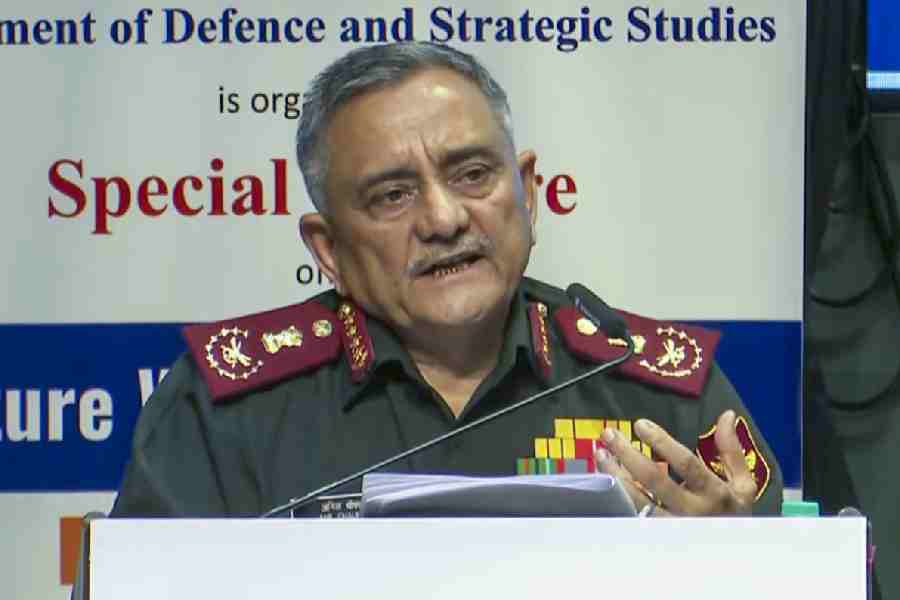 |
Calcutta, Jan. 17: Jyoti Basu, who ruled Bengal for a record 23 years but was stopped by his party from becoming Prime Minister, died today minutes before noon after a 17-day battle with pneumonia.
Basu, 95, leaves behind son Chandan.
“I have come to give you a sad news. Jyoti Basu is no more with us. He has left us… I can’t speak any more,” said Biman Bose, the CPM state secretary, tears welling up in his eyes.
Chandan, who stood next to him, declined to speak with folded hands.
Basu died at 11.47am “due to pneumonia, septicaemic shock and multi-organ failure”, said the hospital where he had been admitted on January 1. A hospital source said the doctors declared Basu dead after health minister Surjya Kanta Mishra, a doctor himself, felt his pulse and confirmed his death.
“We are deeply saddened by the death of our revered leader Jyoti Basu, who was known as a living legend,” chief minister Buddhadeb Bhattacharjee said.
The state government declared a holiday tomorrow for its employees and a two-day state mourning for the departed leader who made history at the head of the world’s longest-running democratically elected communist government.
“It is not a holiday under the Negotiable Instruments Act,” said chief secretary Asok Mohan Chakrabarti, adding that the government was requesting private organisations and educational institutions to close their establishments tomorrow.
Within minutes of Basu’s death being announced, people started converging on the Salt Lake hospital with party flags, flowers and cutouts of the leader. Muted slogans of “Comrade Jyoti Basu, lal salaam, lal salaam” wafted in the chilly afternoon air as Basu’s body wrapped in the red flag emerged from the hospital in a hearse after 3pm.
A couple of thousand people had gathered in front of the hospital. Groups of mourners stood by the side of the road as the hearse made its way in a 30-car convoy to Chandan’s residence nearby and to Indira Bhavan, also in Salt Lake, that had been Basu’s home since 1989 on its way to the mortuary Peace Haven.
Over 100 CPM supporters stood at the central Calcutta funeral parlour with party flags, shouting “Comrade Jyoti Basu amar rahe”. Basu’s body will lie embalmed there all of tomorrow.
On Tuesday, it will be taken to Writers’ Buildings, Assembly, the CPM party office and finally to SSKM Hospital. As Basu had wished, the body will be donated to the medical school.
Mamata Banerjee, who fought many bitter battles with Basu, was the first among Opposition leaders to reach the hospital. “He was the first and last chapter of the Left Front government and Left movement,” she said.
CPM secretary Prakash Karat, who had successfully led the opposition within the party to Basu becoming Prime Minister in 1996, said: “Although he died at the age of 95, he leaves us bereft — because there will be none like Jyoti Basu again.”
Basu had later described the decision of the party’s central committee to reject the proposal to make him Prime Minister as an “historic blunder”. Karat was in town to attend another meeting of the central committee when Basu died.
As a founder member of the CPM, Basu, who joined the communist movement in the forties, was no stranger to history, having won 10 of the 11 elections he contested.
Leading a coalition government for over two decades, he also showed how to hold an alliance together, a fact that was acknowledged today by the increasingly restless CPM partners.
In a nation not known for its politicians stepping down from power, Basu relinquished his post in November 2000, installing Bhattacharjee.
His successor said today: “He was a tall leader and I was a small fry. But he gave me full confidence.”
Although Basu was recognised more as a government than a party man, primarily because of the widely held view that the Bengal CPM was built by Promode Dasgupta, who was its secretary. But it was only partly true. The CPM grew into a monolithic organisation after the Left Front came to power in 1977. It was Basu who captured in his persona the political mood of the times.
Once he felt safe about staying on in power, however, Basu left it to his party to change Bengal in accordance with its script. If land reforms became the landmark policy initiative in the early years — beyond that point the CPM seemed to have lost the plot — Basu became the face of a party that had perfected the art of winning elections.
Basu’s rule came to be identified with CPM rule. On many issues that saw differences between him and the party, it was the party’s writ that eventually ran.
The result was the emergence and consolidation of what has been called “the party society”. For 30-odd years, it was the CPM that electorally profited from this society. If today the tide has turned, the seeds were sown in Basu’s Bengal.
This weight of the party stymied Bengal’s economic prospects after liberalisation. Basu did push for industrialisation, but within the party’s political compulsions.
By the time Bhattacharjee and the CPM came to realise it was time to bring the new economy to Bengal, the long party rule Basu had done little to change made a real breakthrough almost impossible to achieve. With the failures of Basu’s long reign, Bhattacharjee had little chance of success in his late attempts at recovering lost ground for Bengal.
Today, though, the chief minister credited Basu as being the “architect of the industrial policy I am pursuing.… I feel I have to carry on his unfinished work.”
 |











